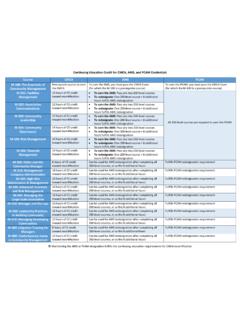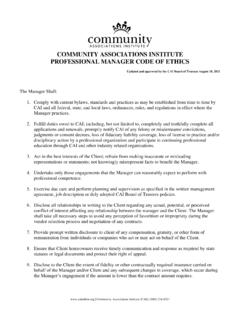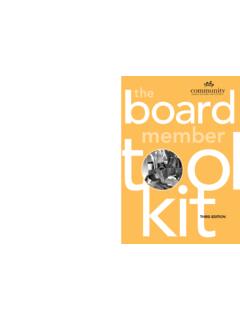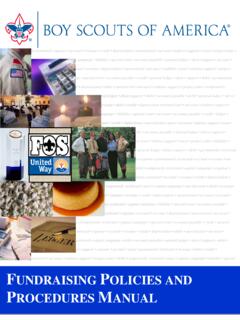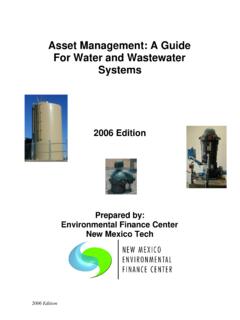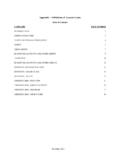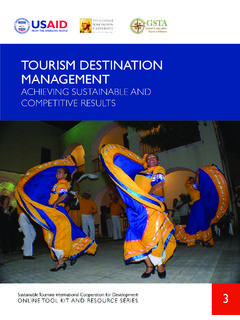Transcription of An Explanation of Reserve Study Standards
1 An Explanation of Reserve Study Standards Based on the National Reserve Study Standards (NRSS)By Robert Browning, rs; Mitch Frumkin, pe, rs; Peter B. Miller, rs; Robert Nordlund, pe, rs; John Poehlmann, rs; and Ted Salgado, rs11/20192 About the AuthorsRobert Browning, pcam, rs, rss, founded Browning Reserve Group nearly 20 years ago in Sacramento, Calif. The company now serves client communities in Nevada and Idaho, as well as throughout California and is affiliated with Community Associations Institute (CAI) and several of its chapters, as well as the Association of Professional Reserve Analysts (APRA) and the California Association of Community Managers (CACM). A former member of CAI s national Board of Trustees, Browning is a past president of CAI s California North Chapter and the Foundation for Community Association Research and an active member of CAI s California Legislative Action Committee, among other volunteer past president of Community Associations Institute and the Foundation for Community Association Research, Mitchell H.
2 Frumkin, pe, rs, was chair of the Reserves Professional Committee during the development of the National Reserve Studies Standards . He is also the former chair of CAI s Big Apple Chapter during its organization. Frumkin is founder and president of Kipcon Engineering and Coolsys Energy Design (formerly Energy Squared), com-panies that provide energy consulting and Reserve Study services to all sizes of communities. In 2016, Frumkin and Browning co-chaired a task force that revised, updated, and improved the National Reserve Study Standards , which now provide a benchmark for Reserve providers and B. Miller, rs, is a principal and founder of Miller-Dodson Associates in Annapolis, Md., one of the leading Reserve Study firms in the An architect by training, Miller is a past president of CAI s Washington Metro Chapter, former board member of CAI s South Caroli-na Chapter, and was vice-chair of CAI s Reserve Professionals Designation Committee from 2002 to 2005.
3 Chair of CAI s Business Partners Council in 2020, Miller received CAI s Excel-lence in Chapter Leadership Award in 2003 and was one of the recipients of CAI s President s Award in 2004. Miller is also a member of the Urban Land Institute and the Congress for the New Urbanism. Robert Nordlund, pe, rs, is founder and chief executive officer of Association Reserves. The 33-year-old company serves clients in all 50 states from its network of regional offices throughout the country. A leading authority in Reserve Study best practices for community associations, Nordlund is a member of CAI s 2018 Business Partners Council and received the organization s Award of Excellence in Designations in Poehlmann, rs, is co-founder and principal of Reserve Advisors, a nationally known Reserve Study firm and a CAI National Corporate Member. Poehlmann is also a member of the task force that developed CAI s National Reserve Study Standards .
4 With more than three decades experience in the Reserve industry, Poehlmann is a former member of CAI s Board of Trustees and is a founding member of CAI s Wisconsin a co-founder and principal of Reserve Advisors, Ted Salgado, rs, is a past president of the Association of Professional Reserve Analysts (APRA) and an active member of CAI s Wisconsin Legislative Action Explanation of National Reserve Study Standards Table of Contents Foreword Reserve Component Inventory Calculating the Percent Funded Reserve Funding Objectives Calculating Reserve Contributions4 Foreword One of the primary responsibilities of any community s board of directors is to protect, maintain, and improve the association s assets. Boards must plan many years in advance to accomplish this objective without reliance on additional funding like special assessments or loans.
5 As Reserve Study professionals, our goal is to give client association boards the tools to anticipate and prepare for the repair and replacement of their communities common elements. A stable and reliable Reserve component list is necessary from year to year, association to association, and pro-vider to provider. The National Reserve Study Standards (NRSS) provide guidance to accomplish this. The four articles here clarify the NRSS to ensure their consistent interpretation and application and to illustrate terms that are used frequently in preparing Reserve authors have no interest in or expectation to tell Reserve professionals how to do their jobs. Rather their purpose here is to offer a clear understanding of the Standards of the common-interest community industry. We all benefit Reserve Study professional and clients alike when Standards are interpreted and applied consistently.
6 5An Explanation of Reserve Study StandardsReserve Component Inventory Selecting Reserve ComponentsThe component inventory is the foundation of every Reserve Study : identifying which expenses are expected to occur, when, and at what cost. For budget planning purposes, a consistent methodology is essential for an association to divide between operating expenses, Reserve expenses, and expenses that fall outside these two categories into other, including capital improvements, insurable losses, true surprises, etc. The following four-part test, clearly described in the NRSS, identifies which components should be funded through reserves. According to the NRSS, an expense must meet all four criteria listed below to qualify as a Reserve expense: 1. Association Responsibility The expense must be the current financial responsibility of the association.
7 These expenses are typically associated with the common elements as defined by the association s governing Limited Useful Life Expectancy The expense must have a reasonably anticipated limit-ed useful life. The useful life limit does not have to be due to physical deterioration but may reach the end of its useful life due to aesthetics (out of style), economic obsolescence (no longer energy efficient), or other reasons. 3. Predictable Remaining Useful Life The next occurrence of the expense must be reason-ably predictable. While unsupported guesses are inappropriate (it is random or unknow-able), estimating when the expense will next occur can be valid if the estimate is based on the association s history ( , historical frequency or patterns of repairs), your judgment, qualified outside opinions, etc. Remaining useful life must always meet your reasonably predictable test, which means you should always be ready with a why.
8 4. Minimum Threshold Cost Finally, the expense must be more than what can be readily absorbed by the association s ongoing annual operating budget. Also, if the expense is not knowable within a reasonable certainty after prudent research, then it fails this four-part test helps all Reserve specialists consistently identify the significant, predictable expenses for which the association should become financially prepared. If an expense doesn t pass all four elements of this test, it should not be funded through the Reserve portion of the association s to the NRSS four-part test ensures a consistent approach and a stable budget plan-ning platform, enhancing our credibility as an industry and minimizing our liability About Useful Life And Remaining Useful Life (RUL)Minimum useful life The NRSS do not define a minimum useful life.
9 Thus, identify expenses occurring as frequently as annually (Useful Life = 1 year) as components if, in your judgment, the client is best served by the expense being funded through the Reserve portion of their budget. Note that some jurisdictions may provide additional guidance or restrictions on this useful life or remaining useful life Although the NRSS require that Reserve studies dis-play a minimum 20 years of income and expenses, the NRSS do not dictate a maximum useful life1 limit. major projects, such as roofing, siding, elevator modernization, etc., may have useful life expec-tancies and remaining useful life expectancies in excess of 20 or 30 years. Homeowners enjoy lower contributions when such large expenditures are spread over the entire useful life of a component, rather than only the last 20 or 30 years2. But such distant projects may fail your reasonable certain-ty test, so use your good judgment in this matter.
10 Remaining Useful Life (RUL) Per the NRSS definition of remaining useful life, an expense anticipated in the initial budget plan-ning year of the Reserve Study should have a zero remaining useful life. See the NRSS Reserve Study Required Contents #14. Also, there should be no negative RUL values. When a project needs to be accomplished, its RUL is zero. The RUL may stay at zero for multiple years if the client continues to defer the project , but it does not go costs The NRSS clearly stipulate in Life and Valuation Estimates and other areas that repair and replace-ment costs that appear in the component list should be for the current year and include all related expenses the association should expect to complete the project materials, labor, shipping, engi-neering and design, permits, installation, disposal, etc. While expenses may be adjusted for inflation in the funding plan, only current costs should appear in the Reserve component list.

